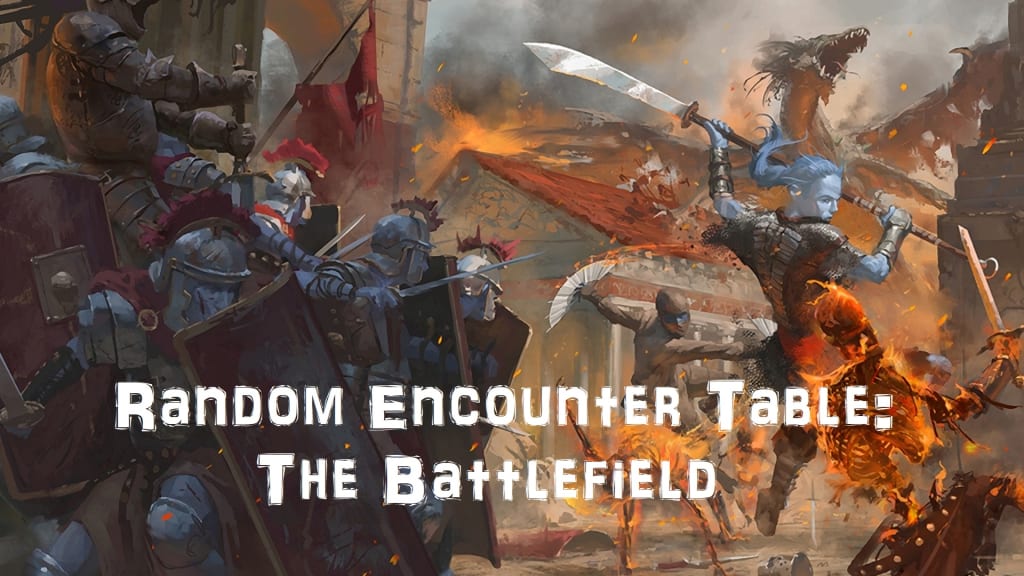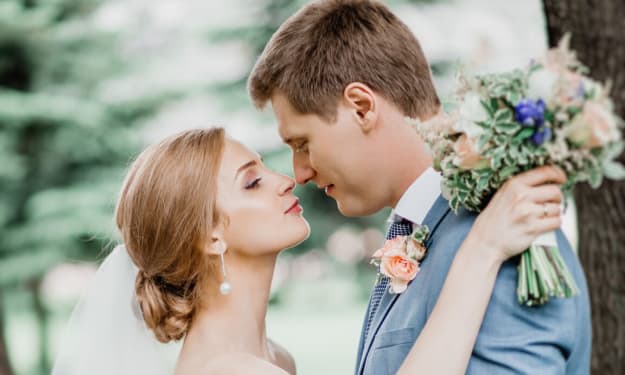Random Encounter Tables: The Battlefield!
A table of 1d20 random battlefield encounters for all your DMing needs.

In my current Dungeons and Dragons campaign, my players had to navigate an enormous battlefield in which two groups of multiplanar beings were at war with one another. I wanted the battlefield to feel lively and threatening, constantly changing around the PCs. To generate this effect, I decided to create a random encounter table!
My players and I both had so much fun working with this table. Even when I rolled the same result more than once, the circumstances of the encounter had changed, resulting in a different impact. The intensity of it was such that my players were waiting with bated breath each time I rolled that d20.
I had trouble finding a pre-existing table of this nature, so I decided to spruce this one up and share it with the world!
I have generalized the description of some of these encounters so that a DM can customize it for any battlefield. I also removed references to specific systems, so this table can be used in any RPG. If you plan on using this in a lengthy encounter, I recommend picking out some generic stat blocks ahead of time to use when the table introduces new enemies.
As a final note: this table assumes that the PCs' objective is to navigate the battlefield, not participate in it. If your PCs are actually participating in the fight, simply treat all of the results as coming from the enemy rather than from both sides.
Random Encounters - The Battlefield
- The defending side takes a decisive victory and charges the battlefield. The party is forced to move back 30 feet to avoid being caught in the charge.
- A unit of the invading side takes notice of the PCs. Roll 1d4 to determine what: 1) 1d6 soldiers 2) 1d4 soldiers and their commanding officer 3) 1d4 mounted soldiers 4) one large unit (dragon, giant, tank, etc.). The enemies are added to the turn order and pursue the party until they leave the battlefield or are slain.
- A unit of the defending side takes notice of the PCs. Roll 1d4 to determine what: 1) 1d6 soldiers 2) 1d4 soldiers and their commanding officer 3) 1d4 mounted soldiers 4) one large unit (dragon, giant, tank, etc.). The enemies are added to the turn order and pursue the party until they leave the battlefield or are slain.
- A fireball or other missile spell lands in the area, dealing damage to all units in a 20-foot radius. Roll 1d4 for the damage type: 1) fire 2) electricity 3) cold 4) acid.
- A random projectile hits the area surrounding the PCs. Roll 1d4 to determine what type of projectile: 1) stone catapult shot; hits one target 2) ballista arrow; hits 1-2 adjacent targets 3) flask of alchemist fire; hits a 10-foot square 4) volley of small rocks; hits a 20-foot square.
- A nearby druid casts a spell (such as Transmute Stone to Mud) that causes the next 40 feet of terrain to behave like quicksand.
- A cavalry of mounted units passes through the area. One melee attack is made against each PC, and each PC hit must make a check to avoid being knocked prone.
- A massive unit (such as a dragon, ogre, or giant) is enraged. It rampages through the area, and the PCs must make a check to avoid being knocked prone.
- A flying unit (such as an airship, gryphon, or dragon) falls from the sky onto the PCs. The flying unit now occupies a random space on the battlefield. Anyone who was standing in a space within an area equal to twice the space occupied by the creature must make a save to avoid being restrained beneath the body of the flying unit. Restrained characters take bludgeoning damage and will need help getting out.
- A flying unit bombards the area. Roll 1d4: 1) a dragon uses its breath weapon 2) an airship fires a volley of cannons 3) a gryphon drops off reinforcements 4) an airship drops hundreds of flasks of alchemical fire.
- The PCs hear a warhorn sound nearby. The morale of the defending or invading side is bolstered (DM's choice). All units of the chosen side receive a +1 to attack and damage rolls for the next 6 rounds.
- A burrowing unit (such as a giant mole or a drill) bursts from the ground beneath the PCs. The burrowing creature now occupies a space of its choosing. Anyone who was standing in a space within an area equal to twice the space occupied by the creature must make a save to avoid being knocked prone. The burrowing unit is added to the turn order.
- A winged, angelic medic flies into the PCs' range and casts a powerful healing spell. This effects all creatures in the area.
- A significant leader or commander suffers grievous harm. Roll 1d2 to determine what side they are on. Units effected by the loss of their leader must make a save to avoid fleeing the battle, including any units who are fighting the PCs. Roll 1d4 to determine what has happened to the leader: 1) injured 2) captured 3) deserted 4) killed.
- A starving creature is drawn to the carnage. Roll 1d3: 1) barghest 2) basilisk 3) gibbering mouther. The creature will pursue the party until slain (even outside of the battlefield).
- A wounded soldier lies in the PCs' path. Roll 1d6 to determine their status: 1) begging for help 2) stoic or in shock 3) feigning injury to lure the PCs 4) trying to drag themselves away 5) unconscious 6) just died, and the PCs must roll to avoid tripping over them.
- A previous ally of one or more of the PCs appears on the battlefield. It is up to the DM what they are doing there and whose side they are fighting for.
- A previous enemy of one or more of the PCs appears on the battlefield. It is up to the DM what they are doing there and whose side they are fighting for.
- A famous hero, powerful outsider, or divine servant of a God makes a dramatic entrance. The being's power is such that all enemy forces are now focused on it. What the being is doing here, whose side it is fighting for, and whether it will help or hinder the PCs is entirely up to the DM. (This result could even be used to end the battle entirely!)
- Retreat! One side (roll 1d2 to determine which) is forced to back down. All units swiftly return to their side of the battlefield. No further results are rolled for the next 1d6 rounds... at which point the fighting resumes in earnest.
If you are using this table in 5e, I recommend using it as part of a complex trap encounter. The battlefield itself is the "trap," and a result is rolled from this table each round on Initiative 20. To end the trap, the PCs must find a way off of the battlefield. To make it more difficult, roll on the table again each time a PC moves more than 30 feet in a round.
I originally ran this table using the above specifications and it was wicked fun. Be sure to pick a map layout that is reasonably large, so your PCs can't just rush through it!
Happy DMing! As always, feel free to share stories with me over on my Twitter. I love hearing about the creative ways in which my tables get used!
About the Creator
Olivia Fishwick
Olivia Fishwick is a freelance writer in Johnson City, Tennessee. She used to live in Arizona, but the desert was already weird enough without her getting involved. She uses Vocal to share stories and anecdotes from her DnD world, Musea.






Comments
There are no comments for this story
Be the first to respond and start the conversation.